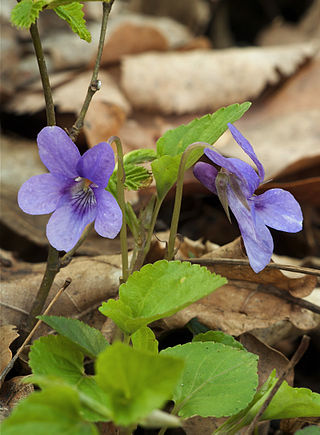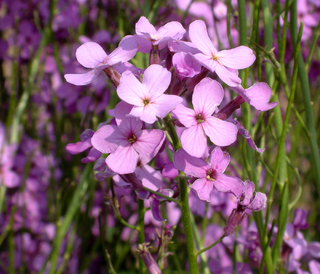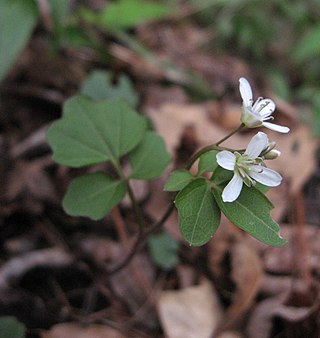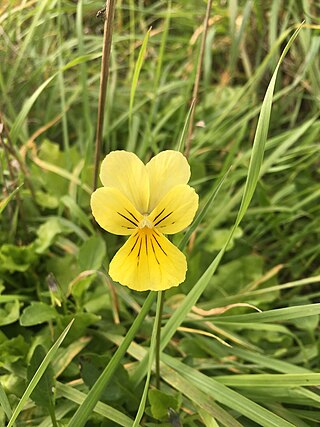
Viola is a genus of flowering plants in the violet family Violaceae. It is the largest genus in the family, containing between 525 and 600 species. Most species are found in the temperate Northern Hemisphere; however, some are also found in widely divergent areas such as Hawaii, Australasia, and the Andes.

Guadalupe Mountains National Park is an American national park in the Guadalupe Mountains, east of El Paso, Texas. The mountain range includes Guadalupe Peak, the highest point in Texas at 8,751 feet (2,667 m), and El Capitan used as a landmark by travelers on the route later followed by the Butterfield Overland Mail stagecoach line. The ruins of a stagecoach station stand near the Pine Springs visitor center. The restored Frijole Ranch contains a small museum of local history and is the trailhead for Smith Spring. The park covers 86,367 acres in the same mountain range as Carlsbad Caverns National Park, about 25 miles (40 km) to the north in New Mexico. The Guadalupe Peak Trail winds through pinyon pine and Douglas-fir forests as it ascends over 3,000 feet (910 m) to the summit of Guadalupe Peak, with views of El Capitan and the Chihuahuan Desert.

Hesperis matronalis is an herbaceous flowering plant species in the family Brassicaceae. It has numerous common names, including dame's rocket, damask-violet, dame's-violet, dames-wort, dame's gilliflower, night-scented gilliflower, queen's gilliflower, rogue's gilliflower, summer lilac, sweet rocket, mother-of-the-evening, Good & Plenties, and winter gilliflower.

Guadalupe Island is a volcanic island located 241 kilometres off the western coast of Mexico's Baja California Peninsula and about 400 km (200 nmi) southwest of the city of Ensenada in the state of Baja California, in the Pacific Ocean. The various volcanoes are extinct or dormant. In 2005 Guadalupe Island and its surrounding waters and islets were declared a biosphere reserve to restore its vegetation and to protect its population of marine mammals and birds. The island is a popular destination for great white shark cage diving. Guadalupe Island is inhabited only by scientists, military personnel operating a weather station, and a small group of seasonal fishermen. The island is mostly arid and has very little surface water.

Linnaea borealis is a species of flowering plant in the family Caprifoliaceae. Until 2013, it was the only species in the genus Linnaea. It is a boreal to subarctic woodland subshrub, commonly known as twinflower.

Viola persicifolia, the fen violet, is a violet, native to central and northern Europe and northern Asia. In the British Isles it is very rare, occurring in a few fens in England and near the western coast of Ireland.

Cupressus guadalupensis, the Guadalupe cypress, is a species of cypress from Guadalupe Island in the Pacific Ocean off western North America.

The Santa Cruz cypress is a species of North American tree within the Cypress family. The species is endemic to the Santa Cruz Mountains within the Santa Cruz and San Mateo counties of west-central California. The U.S. Fish and Wildlife Service listed the species on the Endangered Species Act in 1987 due to increasing threats from habitat loss and disruption of natural forest fire regimes. In 2016, the conservation status of the Santa Cruz cypress changed to Threatened. The cited reasoning was a decrease in threats against their habitat.

Viola lutea, the mountain pansy, is a species of violet that grows in Europe, from the British Isles to the Balkans.

Bidens amplectens, the Waiʻanae kokoʻolau, is a species of flowering plant in the family Asteraceae. It belongs to the genus Bidens, collectively called kokoʻolau or koʻokoʻolau in the Hawaiian language. It is found in coastal and dry lowland habitats in the Waiʻanae Range on Oʻahu. It is threatened by habitat loss due to the spread of invasive weeds and brush fires. The species is also threatened by climate change and habitat degradation, and herbivory. Bidens amplectens is currently listed as endangered under the Endangered Species Act.

Orobanche uniflora, commonly known as one-flowered broomrape, one-flowered cancer root, ghost pipe or naked broomrape, is an annual parasitic herbaceous plant. It is native to much of North America, where it is a parasitic plant, tapping nutrients from many other species of plants, including those in the families Asteraceae and Saxifragaceae and in the genus Sedum. The name "orobanche" can be translated to "vetch-strangler" and "uniflora" can be translated to "single-flower".

Cupressus forbesii, now reclassified by some as Hesperocyparis forbesii, and with the common names Tecate cypress or Forbes' cypress, is a species of cypress native to southwestern North America.

Viola adunca is a species of violet known by the common names hookedspur violet, early blue violet, sand violet, and western dog violet. It is native to meadows and forests of western North America, Canada, and the northern contiguous United States.

Dudleya brevifolia, is a rare succulent plant known by the common name short-leaved liveforever, short-leaved dudleya or rarely the Del Mar Hasseanthus. It is an edaphic endemic that only grows on the mesas of the most ancient marine terraces, hiding in the vicinity of ironstone concretions. The leaves are deciduous, and disappear after the inflorescence develops. The small white flowers are star-shaped with a yellow center. After flowering, any above ground trace of the plant will disappear, and it survives under the earth with a starch-rich subterranean caudex. Dudleya brevifolia is only found on coastal mesas along a small strip of coast in San Diego County, California.

Nepenthes pitopangii is a tropical pitcher plant endemic to the Indonesian island of Sulawesi. Discovered in 2006, N. pitopangii was initially known from a single plant at a remote locality in Lore Lindu National Park. Efforts made in the following years to locate further populations on surrounding mountains proved unsuccessful. In March 2011, a new population of N. pitopangii consisting of around a dozen plants was discovered more than 100 km from the type locality. Nepenthes pitopangii appears to be closely related to N. glabrata, from which it differs most obviously in its upper pitcher morphology.

South Chilcotin Mountains Provincial Park is a provincial park in British Columbia, Canada, located on Highway 40 northwest of Lillooet, British Columbia. The park, which is 56,796 ha. in size, was established on April 18, 2001, and It was created out of a portion of the Spruce Lake Protected Area. The park is located on three Indigenous Nations: The Tsilhqot’in, St’at’imc, and Secwepemc.
Passiflora lindeniana is a species in the subgenus Astrophea, some species of which are weak trees and some are free standing woody trees. P. lindeniana is the largest of the free-standing trees, growing to 20 m, and having a circumference of 1.25 m at the base.

Viola selkirkii is a species of violet known by the common names Selkirk's violet and great-spur violet. It is native throughout the Northern Hemisphere, its distribution circumboreal.

Cardamine flagellifera, commonly known as Blue Ridge bittercress, is a species of herbaceous plant in the mustard family. It is native to eastern North America, where it is found primarily in the southern Blue Ridge. It is a perennial that produces white flowers in the spring.

Viola lutea subsp. calaminaria is a subspecies of V. lutea, in the violet family, the Violaceae. The plant occurs from Kelmis in the Belgian province of Liège across the borders to Germany and the Netherlands. The plant has adapted to an excess of zinc in the tailings of a former mines, the heaps of stone left over after separating the valuable fraction of ore. By evolving the ability to cope with the toxic heavy metal pollution, this violet has gained an advantage over the other plants in the ecosystem, as is able to become the locally dominant floral component of such habitats.



















